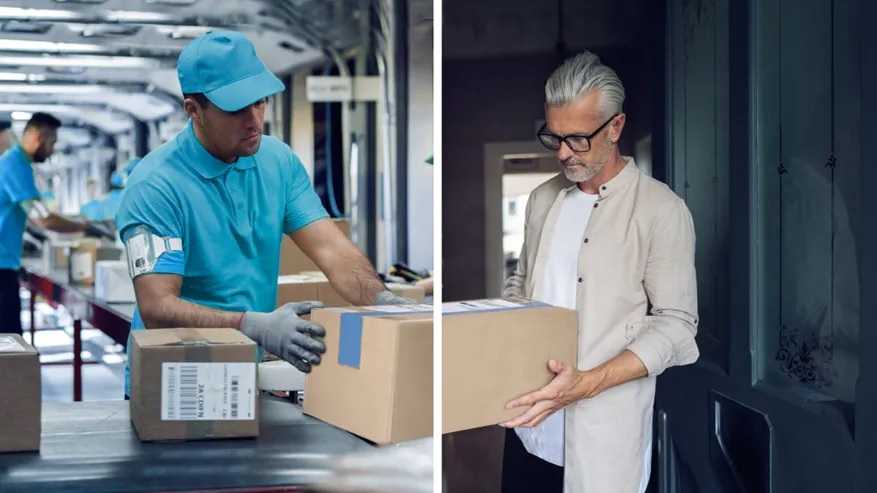Seven ways to optimise, and build greater visibility into, your retail supply chain in 2023

It’s a challenging market for retailers and against the backdrop of continued economic instability caused by rising inflation and the cost of living, it’s never been more important to have a modern, robust supply chain that operates with the greatest levels of efficiency.
In 2023, one of the biggest challenges that retailers face is the complexity of bringing increased visibility into their logistics. Driven by the availability of digital technology, along with other tried-and-tested tactics, your brand now has the opportunity to optimise its operations and increase visibility, building an unbreakable retail supply chain that works for you and your customers.
An October 2022 report from McKinsey highlights that ‘digital interactions are the norm’ and that ‘increasing digital sales require an expansion of the supply chain and logistics network.’ With the continuing rise and growth of e-commerce retail, brands need to embrace new strategies to develop seamless supply chains and unified shopping experiences for consumers.
From overcoming the overstocking crisis to integrating new digital technologies, here we take a closer look at some of the ways in which European retailers can unlock greater agility and resilience to build a future-facing retail supply chain.
Embrace near-sourcing
Having the ability to be reactive and responsive is crucially important for brands operating within the retail space. One of the tactics which greatly enables this is near-sourcing – bringing elements of your operations closer to Europe to avoid disruptions.
This is something that many brands are currently embracing, relocating their warehousing from parts of Asia to countries such as Turkey, which places them closer to market and in a better position to react to changing circumstances.
As we contend with a volatile global economy, you need a supply chain setup that allows you to flex and adapt to meet increased or declining demand. Moving operations closer to European markets gives you the power to be reactive, speeding up or slowing down your flow of products, depending on changing factors.
\Connect the dots with data

Achieving a seamless supply chain is no easy feat, and without a clear overview of orders, processes and timescales, it can become a struggle to manage your operations and deliver for your customers.
Communication is key to achieving supply chain harmony and maintaining visibility over all aspects of the logistics journey. Through adopting the use of an online supply chain management platform, you can track progress through the integration of real-time data insights; produce reports quickly and efficiently; manage communications with vendors; and streamline customs clearances – all through one centralised platform.
Having clear visibility over all elements of your supply chain is crucial and to ensure success throughout 2023, you should look to harness the power of supply chain management tools to streamline your logistics and automate your processes.
A prominent retailer told us they had a recurring issue with detention and demurrage (D&D) costs mounting at destinations, with the root cause being the unavailability of data to the destination. This challenge was almost immediately mitigated by implementing real-time visibility through our online tool, providing alerts to the destination which warned of approaching D&D exposure. The impact of data availability, and connecting the data to reality, resulted in tremendous cost savings to the customer and revenue to Maersk through gain-share agreements.
Sam Minocher
Head of Customer Implementation, Europe at Maersk

Explore digital twin technologies
As new technologies begin to emerge that bring visibility and predictability to retail supply chains, now is the time to look at how problem-solving and decision-making can be enhanced by digitisation.
An area that Maersk is currently investigating, and investing in, is digital twin technology – the ability to create true-to-life digital representations of physical assets. For example, a digital representation of a warehouse or factory floor which allows brands to maintain a clear overview of their assets in real time.
Although we’re not quite there yet in terms of the wider roll-out of this technology, it’s certainly something that you should be keeping your eye on. Digital twins have the ability to revolutionise the way supply chains operate and the ability for brands to forecast with precision.
Build a seamless omnichannel strategy
To bring greater agility, resilience and visibility into your supply chain, it's critical to embrace omnichannel fulfilment to ensure that you're operating the most effective and streamlined e-commerce strategy possible.
With many overstocked warehouses across Europe, due to the ongoing unpredictability of the economic situation, knowing how much inventory to hold – and where – isn't the easiest problem to solve. But by having the right setup in destination countries, you can flow your stock more accurately through the supply chain, providing you with greater control over your operations.
Whether you’re operating across the B2B, B2C or D2C spaces, consolidating stock into one centralised inventory brings greater visibility to your supply chain and allows for better, smarter decision-making to avoid the risk of overstocking and keeping capital tied up in warehouses.
Find warehousing that works for you
To build a truly global footprint as a brand, it’s important to have the right warehousing solutions in the right strategic locations to enable you to flow your inventory as fast as is required to meet demand. Brands need to be resilient, and Maersk’s logistics expertise can enable you to bring greater efficiency to the journey between warehouse and store, or warehouse and consumer.
Our warehousing solutions also help to bring greater visibility to customers’ supply chains. Through investment in data-driven technology, such as warehouse management systems, you can maintain a clear overview of your operations, respond quickly to complexities in the supply chain, and respond in real time to the ever-changing needs of your consumers.
Deliver value – down to the last mile

It’s the moment of truth for consumers. Whether a delivery arrives on time or not could mean the difference between retaining a customer... or not.
Consumers have high expectations of brands when it comes to delivery options. They’re looking for the right cost and accuracy, but they’re also increasingly looking for delivery services that prioritise the environment and give them greater visibility over their product’s journey. With this in mind, you have an opportunity to enhance your last-mile logistics and create a supply chain that works for you, and your customers.
With access to a range of trusted last-mile carriers, a partnership with Maersk allows you to align your last-mile strategy with your inventory management and omnichannel fulfilment solutions, balancing speed and sustainability, and delivering at the best available cost to you.
A leading retailer with warehouse operations in Germany has benefitted significantly from Maersk’s last-mile delivery options from the port of Rotterdam. We have implemented multi-modal services using barge, rail, barge-truck and truck only options to meet the varying needs of the customer’s warehouse operations. The warehouse can make a call by midday for next-day deliveries, which is achieved using a barge-truck option or a two-day option via rail only. The flexibility offered is second-to-none and on-time delivery is achieved 98.5% of the time.
Sam Minocher
Head of Customer Implementation, Europe at Maersk
Invest in your e-commerce strategy
As the world of e-commerce continues to evolve, retail brands are looking for new ways to maintain a high level of visibility across the supply chain, while also meeting the increasing expectations of customers and putting strategies in place to delight, and retain, them.
By investing in owned e-commerce channels, alongside the major third-party platforms and marketplaces, you can build better relationships with your customers and learn more about them – their names and addresses, their interests, and the products they like, for example. The visibility of this data can be critical, allowing you to build more accurate customer profiles and capitalise on the lifetime value of your customers.
But the value of this data goes much deeper than this. You can even use this data to drive product development. Understanding what your customers like and dislike will help you to tailor your product offering to the needs of your current, and potential future, customers.
Now more than ever, it’s vital that retail brands maintain a clear overview of their end-to-end logistics, utilising new technologies, along with tried-and-tested tactics, to operate a seamless, cost-effective and future-facing supply chain.
From data-led approaches to the strategic positioning of assets to ensure speed, accuracy and optimum preparedness, there’s plenty that retail brands can do to get ahead in 2023. As the world adapts to economic strains, brands need to continue to think innovatively and creatively about the investments they make in their supply chain – building a logistics setup that allows for success today and into the future.

Sam Minocher
Global Customer Contract Delivery Manager - Europe, Maersk
